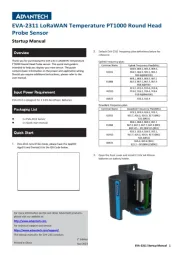Industrial Music Electronics Kermit Mark III Handleiding
Industrial Music Electronics
Niet gecategoriseerd
Kermit Mark III
Bekijk gratis de handleiding van Industrial Music Electronics Kermit Mark III (9 pagina’s), behorend tot de categorie Niet gecategoriseerd. Deze gids werd als nuttig beoordeeld door 61 mensen en kreeg gemiddeld 4.3 sterren uit 31 reviews. Heb je een vraag over Industrial Music Electronics Kermit Mark III of wil je andere gebruikers van dit product iets vragen? Stel een vraag
Pagina 1/9

KERMIT MARK III
OPERATIONS MANUAL • FIRMWARE V1.0

FUNDAMENTALS
Kermit is a 4-channel tempo-synced wavetable oscillator (optimized for LFO operation) that has many generation
modes. The A and B channels have full controls and a high sampling rate. The C and D channels have some shared
controls, but with nearly the same capability of the A and B channels. Kermit is only a 12HP module, so the user
interface is economized. Some controls are shared. “Deep” parameters and CV/modulation assignments are made by
using “hotkeys”. Each channel has a button that, when held down, changes the action of all the knobs on the module.
For example, on channels A or B, you can access the deep parameters of ne tune, phase, and waveform bank by
holding down the channel button and turning the frequency, amplitude, or waveform knob respectively.
To assign the channel’s external CV input to a parameter, hold down the rotary encoder’s button and turn the
destination knob. To cross-modulate a parameter with the output of another channel, hold down the source channel’s
button and turn the knob of the desired destination parameter. When any of these hotkey actions are used, a window
will pop up on the display showing the name of the parameter being changed and a visual representation of the
modulation amount. After a few seconds, this popup display will go away and the main screen will reappear. To exit
from the popup sooner, press a nearby channel button.
Channels C and D have limited controls. The single knob for each channel normally controls the coarse frequency.The
following table shows the assignment key combinations necessary to program the modulation matrix for channels C
and D.
Each channel has an LED near its output which displays its absolute voltage from -6V (led OFF) to +6V (led brightest).
When the amplitude of the channel is attenuated, the LED will tend towards medium brightness instead of OFF. Use the
channel at full scale amplitude to make full use of the LED indicator.
SCREEN SAVER
The Kermit’s display is an OLED. It is set to a brightness to provide the best balance between visibility and long
life. To preserve the life and maximum brightness of the OLED, it will turn off if a button or encoder is not used for 10
minutes. To turn it back on, press a button or turn the encoder.
MK III MENU SYSTEM
Most buttons on Industrial Music Electronics modules have hidden menus associated with them. To access them,
hold down the rotary encoder button and push a button. The menu will appear on the display. Turn the encoder to
select the desired menu item. Push the encoder to select the item, and turn the encoder to change the value of the
selected item. Push the encoder button again to enter your selection. Exit the menu by pressing any of the other
buttons. If a button does not have a menu associated with it, then the button press combination will usually invoke
another shortcut function.
The menus for channel C and D are shared, and accessed by the one channel C/D button. To access the channel
D menu, enter the channel C menu and keep scrolling down.
GETTING STARTED
Select modes for each channel. Enter the menu for each channel and look at the parameters "Channel Type" and
"Mode". The Type option selects the class of functions: LFO, oscillator, envelope, random, or S+H. Each oscillator
type has three Modes associated with it Details are given in the "MODE OVERVIEW" section.
MODE SELECT SHORTCUT
Hold down the PRESET button and press one of the channel buttons to increment the channel's mode/type selection.
You can quickly cycle through the 12 possible modes this way. To increment channel D, hold down both the Preset and
Tap buttons, then press the channel C/D button.
HOLD DOWN THE FOLLOWING bUTTONS WHILE TURNING THE C/D kNObS TO ACCESS ALL PARAMETERS:
Amplitude Waveform FIne Tune Phase Wave Bank
A b A+C/D b+C/DC/D

TAP TEMPO
On the lower right corner of the main screen, the global tempo of Kermit is shown. You can set the tempo by using
the "Tap" controls on the lower left of the module. By rhythmically tapping the button or using an external clock signal,
the global tempo will update. Many of Kermit's channel modes are aware of the tempo, and will modify their frequency
according to changes in the tempo. Should one of these channels become desynced from the other channels due to
parameter modulation, hold down the encoder button and press the tap key to reset all Tempo-aware channels on the
next tap event. You can also send a trigger to the Preset CV
input if the preset mode is not active. If Preset mode is active,
simply change to a different preset, the channels will reset their
phase.
CV INPUTS
Each of Kermit's control blocks have a CV input. The voltage at this input can be assigned to any of the main
parameters of frequency, amplitude, and waveform. To begin assignment, hold down the rotary encoder and turn the
desired knob. The display will change to show the selected assignment and a bar graph of its amount. This control
assignment works as an "attenuverter", where the center position means that there is NO assignment.
All CV inputs on the Kermit accept full-scale, bipolar control voltages with a range of +/-10v. The response
of the various inputs are scaled to provide a musically useful range of motion within the typical range of +/-5V,
with additional reactivity far outside of this range. The virtual attenuverters use a nonlinear curve to allow a typical
control voltage to subtly modulate a small range of the parameter, or full-swing travel without the use of external
amplication.
kEY/kNOb COMbINATIONS FOR CV ASSIGNMENT
MODULATION MATRIX: Hold down buttons in order while turning the destination knob
Like the CV input assignment, you can also assign the output of any Kermit channel to modulate any of the main
parameters on another channel. The assignment principle is the same: hold down a key combination while turning the
knob of the destination parameter.
Turn
COUNTER-
CLOCKWISE
to SUBTRACT
Turn CLOCKWISE to ADD CV to parameter
“Attenuverter”
CV Input
CV > Freq CV > Amp CV > Wave
Channel A,B Hold Encoder, turn Freq Hold Encoder, turn Amp Hold Encoder, turn Wave
Channsl C Hold Encoder, turn knob Hold Encoder + A, turn knob Hold Encoder + B, turn knob
Channel D Hold Encoder, turn knob Hold Encoder + A, turn knob Hold Encoder + B, turn knob
Channel A Channel b Channel C Channel D
Channel A b C/D C/D, ---
Encoder
Channel b C/D, A --- C/D
Encoder
Channel
C/D Freq
A, C/D,
Encoder
b, C/D,
Encoder
C/D,
Encoder
C/D,
Encoder
Channel C
/D Amp
A, C/D, Tap b, C/D, Tap C/D, Tap C/D, Tap
Channel
C/D Wave
A, C/D, Tap,
Encoder
b, C/D, Tap,
Encoder
C/D, Tap,
Encoder
C/D, Tap,
Encoder
DESTINATION
SOURCE
Product specificaties
| Merk: | Industrial Music Electronics |
| Categorie: | Niet gecategoriseerd |
| Model: | Kermit Mark III |
Heb je hulp nodig?
Als je hulp nodig hebt met Industrial Music Electronics Kermit Mark III stel dan hieronder een vraag en andere gebruikers zullen je antwoorden
Handleiding Niet gecategoriseerd Industrial Music Electronics
Handleiding Niet gecategoriseerd
- ILive
- IDance
- Jetway
- Mammut
- SurgeX
- Leaptel
- NordicTrack
- Rapoo
- Flavel
- Cigweld
- AFX
- Edesa
- Banana Pi
- Roadworx
- Seville Classics
Nieuwste handleidingen voor Niet gecategoriseerd

5 Augustus 2025

5 Augustus 2025

5 Augustus 2025

5 Augustus 2025

5 Augustus 2025

5 Augustus 2025

5 Augustus 2025

5 Augustus 2025

5 Augustus 2025


